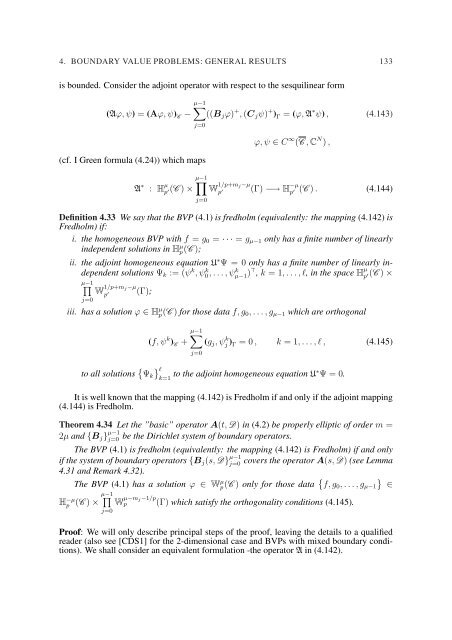EQUATIONS OF ELASTIC HYPERSURFACES
EQUATIONS OF ELASTIC HYPERSURFACES
EQUATIONS OF ELASTIC HYPERSURFACES
You also want an ePaper? Increase the reach of your titles
YUMPU automatically turns print PDFs into web optimized ePapers that Google loves.
4. BOUNDARY VALUE PROBLEMS: GENERAL RESULTS 133<br />
is bounded. Consider the adjoint operator with respect to the sesquilinear form<br />
µ−1<br />
∑<br />
(Aϕ, ψ) = (Aϕ, ψ) C − ((B j ϕ) + , (C j ψ) + ) Γ = (ϕ, A ∗ ψ) , (4.143)<br />
j=0<br />
(cf. I Green formula (4.24)) which maps<br />
j=0<br />
ϕ, ψ ∈ C ∞ (C , C N ) ,<br />
µ−1<br />
∏<br />
A ∗ : H µ p<br />
(C ) × W 1/p+m j−µ<br />
′ p<br />
(Γ) −→ H −µ<br />
′ p<br />
(C ) . (4.144)<br />
′<br />
Definition 4.33 We say that the BVP (4.1) is fredholm (equivalently: the mapping (4.142) is<br />
Fredholm) if:<br />
i. the homogeneous BVP with f = g 0 = · · · = g µ−1 only has a finite number of linearly<br />
independent solutions in H µ p(C );<br />
ii. the adjoint homogeneous equation U ∗ Ψ = 0 only has a finite number of linearly independent<br />
solutions Ψ k := (ψ k , ψ0, k . . . , ψµ−1) k ⊤ , k = 1, . . . , l, in the space H µ p<br />
(C ) ×<br />
′<br />
µ−1 ∏<br />
W 1/p+m j−µ<br />
p<br />
(Γ);<br />
′<br />
j=0<br />
iii. has a solution ϕ ∈ H µ p(C ) for those data f, g 0 , . . . , g µ−1 which are orthogonal<br />
µ−1<br />
∑<br />
(f, ψ k ) C + (g j , ψj k ) Γ = 0 , k = 1, . . . , l , (4.145)<br />
j=0<br />
to all solutions { Ψ k<br />
} l<br />
k=1 to the adjoint homogeneous equation U∗ Ψ = 0.<br />
It is well known that the mapping (4.142) is Fredholm if and only if the adjoint mapping<br />
(4.144) is Fredholm.<br />
Theorem 4.34 Let the ”basic” operator A(t, D) in (4.2) be properly elliptic of order m =<br />
2µ and {B j } µ−1<br />
j=0 be the Dirichlet system of boundary operators.<br />
The BVP (4.1) is fredholm (equivalently: the mapping (4.142) is Fredholm) if and only<br />
if the system of boundary operators {B j (s, D} µ−1<br />
j=0 covers the operator A(s, D) (see Lemma<br />
4.31 and Remark 4.32).<br />
The BVP (4.1) has a solution ϕ ∈ W µ p(C ) only for those data { }<br />
f, g 0 , . . . , g µ−1 ∈<br />
p (C ) × µ−1 ∏<br />
W µ−m j−1/p<br />
p (Γ) which satisfy the orthogonality conditions (4.145).<br />
H −µ<br />
j=0<br />
Proof: We will only describe principal steps of the proof, leaving the details to a qualified<br />
reader (also see [CDS1] for the 2-dimensional case and BVPs with mixed boundary conditions).<br />
We shall consider an equivalent formulation -the operator A in (4.142).

















